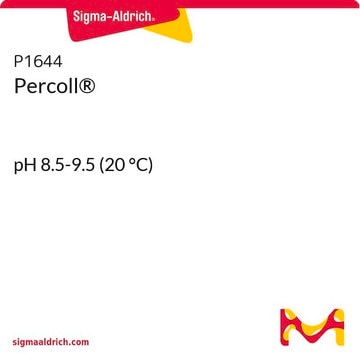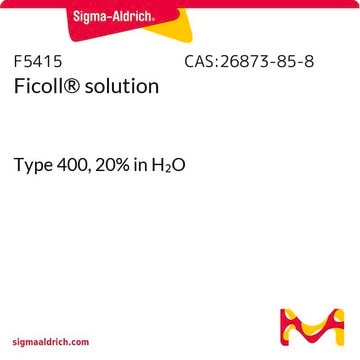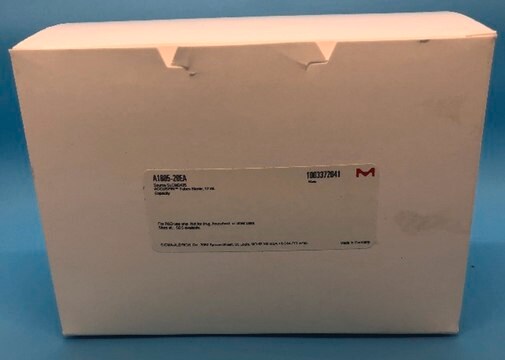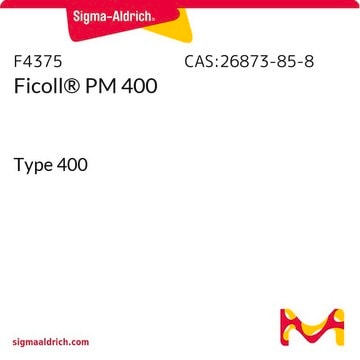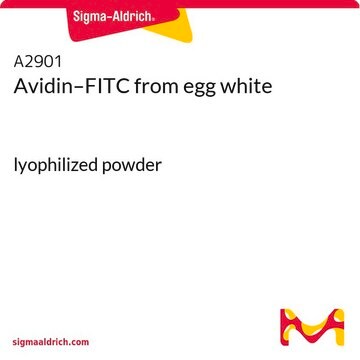Histopaque and Ficoll Paque are chemically identical solutions. For all practical purposes, both have polysucrose 400.
11191
Histopaque®-1119
sterile-filtered, density: 1.119
Select a Size
Select a Size
About This Item
Recommended Products
sterility
sterile-filtered
Quality Level
form
liquid
shelf life
Expiry date on the label.
technique(s)
cell culture | mammalian: suitable
impurities
endotoxin, tested
density
1.119
application(s)
hematology
histology
storage temp.
2-8°C
General description
Application
Features and Benefits
- Optimal recovery of viable cells
- Permits selective separation of blood cell types
- Prevents cell distortion
- Preserves cell viability
- Minimal extraneous cell interference
- Reproducible performance from batch to batch
- Sterile-filtered and endotoxin-tested
- Stable at 2-8°C for at least 2 years when protected from light
Principle
Legal Information
related product
Signal Word
Warning
Hazard Statements
Precautionary Statements
Hazard Classifications
Eye Irrit. 2 - Met. Corr. 1 - Skin Irrit. 2
Storage Class Code
8A - Combustible corrosive hazardous materials
WGK
WGK 3
Flash Point(F)
Not applicable
Flash Point(C)
Not applicable
Choose from one of the most recent versions:
Already Own This Product?
Find documentation for the products that you have recently purchased in the Document Library.
Customers Also Viewed
Articles
Centrifugation enables the separation of particles by sedimentation. Learn how to separate particles using a centrifuge and how to use Stokes' law to calculate the velocity of sedimentation.
Protocols
This troubleshooting guide addresses the most common sources of error observed when using Histopaque but is not meant to be a comprehensive list.
Ficoll 400® is a non-ionic polymer with high hydrophilicity and water solubility, suitable for various biological applications.
-
Is it possible to use Histopaque 1119 as a double gradient media with another brand of density gradient media, such as Ficoll paque plus, or does it only work with Histopaque 1077?
1 answer-
Helpful?
-
-
Is the Histopaque-1119 solution compatible with blood stored in PAXgene cell-free DNA tubes for separating different cells from the blood when used in combination with Histopaque-1077 for a double gradient?
1 answer-
The PAX gene Blood DNA tubes were not tested for compatibility with any of the Histopaque products. As a general rule, fresh blood provides the best results with the Histopaque products, and it is generally not recommended to use blood stored for more than 24 hours.
Helpful?
-
-
Are there any comparable products for Pancoll at densities 1.119 g/ml and 1.077 g/ml, to be used in cell isolation for gene expression studies or diagnostics.
1 answer-
As Pancoll is polysucrose-based, Histopaque and Ficoll Paque have essentially the same formulations. For Histopaque and Ficoll Paque, products are available with densities of 1.073, 1.077, 1.083, 1.084, and 1.119 g/ml. Any of the Histopaque and Ficoll Paque products with densities of 1.077 g/ml and 1.119 g/ml should be suitable crossmatches for Pancoll products with densities of 1.077 g/ml and 1.119 g/ml.
Helpful?
-
-
Is there a product similar to Mono-Poly resolving media?
1 answer-
The Mono-Poly resolving media has only a slight difference in formulation compared to Histopaque 11191, primarily in its density which can vary from 1.112 to 1.116 g/ml. In contrast, the specification for Histopaque 11191 is 1.119 g/ml +/- 0.001 g/ml.
Helpful?
-
-
Hi. I am trying to adapt an older protocol that calls for a certain percentage of Ficoll. What percentage does this product contain?
1 answer-
This product is a mixture of Ficoll (polysucrose 400) and sodium diatrizoate at 60 grams and 167 grams per liter, respectively. The solution may not be a suitable substitute for protocols requiring Ficoll, only. Please see product F5415 to review a 20% Ficoll solution in water. This item may a better option:
https://www.sigmaaldrich.com/product/sial/f5415Other pure Ficoll products are available. See these potential product numbers below:
F4375
F2637
F8016
F9378
F8636
F1418
GE17-0300-50
GE17-0300-10
GE17-0300-05Helpful?
-
-
When using Product 11191, Histopaque®-1119, what is the expected percent recovery for the band containing neutrophils.
1 answer-
No percent recovery data has been generated. Due to the importance of technique with the Histopaque 1119-1, percent recovery varies with the skill of the operator.
Helpful?
-
-
The Product 11191, Histopaque®-1119, froze in transit. Is the product still suitable for use?
1 answer-
Mix the bottles upon receipt several times to ensure the product is uniform. The products are shipped ambient and gradients in situ can form if the solution freezes during transport. As long as the bottle has not broken and no precipitate is noted, the product is suitable for use after slowly thawing and mixing.
Helpful?
-
-
Can the procedure for using Product 11191, Histopaque®-1119, be used successfully with species such as rats and mice?
1 answer-
The Histopaque 1119-1 procedure was developed for use with human blood. Due to the lower number of circulating neutrophils in rat or mouse peripheral blood, the technique tends not to work as well with rats or mice.
Helpful?
-
-
What is the Department of Transportation shipping information for this product?
1 answer-
Transportation information can be found in Section 14 of the product's (M)SDS.To access the shipping information for this material, use the link on the product detail page for the product.
Helpful?
-
-
Can the procedure for Product 11191, Histopaque®-1119, be performed using the various Accuspin products?
1 answer-
No. Accuspin products are intended for use with just a single density gradient - such as Histopaque® 1077.
Helpful?
-
Active Filters
Our team of scientists has experience in all areas of research including Life Science, Material Science, Chemical Synthesis, Chromatography, Analytical and many others.
Contact Technical Service


